Perhaps the biggest upgrade in the AMD Ryzen 7000 series is not just the transition to Zen 4 microarchitecture. To us, the biggest change is really the transition from the AM4 platform to AM5. With the transition, AMD was able to offer more features like DDR5, PCIe Gen5, additional display outputs (and more integrated GPU support), and higher-speed USB. In this piece, we are going to explore the new platform. This piece will be followed by our formal AMD Ryzen 9 7950X review in a few days.
Editor’s note: Over the past week, we have been working on our AMD Ryzen 9 7950X review. The key challenge we had was that we received our test system, an awesome Falcon Northwest Talon, less than a week ago. STH also agreed to an embargo of September 27, 2022, while many sites and analysts, both larger and smaller had a September 26, 2022 embargo if they were part of CPU-only media. Alas, this is confusing, but the key challenge we had was that we had less than a week to prepare our review. As a result, we are parsing the review into certain sections talking about the new chips.
Here is that system review if you want to see the platform in action:
AMD Ryzen 7000 Series Platform Overview
First, let us start with the AMD Ryzen 7000 series SoC. We will then expand out to the AMD Socket AM5 platform.
AMD’s general methodology for building high-performance chips, from Zen 2 onwards, has been to use one or two CCDs with cores and caches, with an IO Die (IOD) that has the company’s memory controllers, PCIe controllers, and other I/O. The CCD’s we will deep dive on in our Zen 4 piece later this week, but we wanted to focus on the IOD here.

The new IOD is built on a 6nm process. This is a big shrink over previous generations. AMD’s strategy is that it is able to use a less expensive process for features like the PCIe and memory controllers and more expensive process technology for its main cores and CCDs. This is a huge improvement. AMD is not just adding PCIe Gen5 here, and DDR5, but it also has enough space to fit an integrated RDNA 2 GPU.
This GPU is not the fastest by any means, but integrated GPUs are very useful for troubleshooting and for those that simply do not need PCIe add-in GPUs. We use integrated GPUs on workstations often when we use high-speed NICs in consumer-style platforms and for troubleshooting. AMD’s solution offers AV1 decode (not encode), and h.264/ HEVC decode and encode. It also offers many display output capabilities. When we get to the next section on the AM5 platform and show our test system, the impact of this will be immediately obvious.

For those wondering which standards the new 6nm IOD integrated GPU supports, here is a table.

The other enormous implication is the die size and transistor count. The IOD has shrunk by 2.4% while adding this integrated graphics capability and more I/O connectivity. When we look forward to AMD’s next-gen server and high-end workstation platforms, this should be extremely exciting to STH readers. AMD is set to increase PCIe Gen5 lanes and memory channels in those chips. Currently, with the Zen 3 generation of parts, the I/O die is a major consumer of power and space. A newer smaller IOD technology is going to give AMD more flexibility in designing its larger-scale platforms going forward. In the client space, this also means we get features like the integrated GPU.
AMD Socket AM5 Platform
Another major innovation on the platform is that AMD has moved to a new socket design. The AM4 platform used CPUs with exposed pins that one could easily damage if a large heatsink was stuck to a CPU. AM4 has felt very old for years now, but it was a cheaper technology for AMD to implement as it re-entered the performance market with Zen (1). Now, AMD has its socket AM5 that uses a LGA1718 (Intel Alder Lake is LGA1700 for comparison.) AMD’s CPUs feel more like Intel CPUs with the new AM5 design.

Expanding the pin count via a transition to LGA from 1331 to 1718 pins means that AMD has a lot more I/O to work with on the new chips. While the transition to DDR4 and DDR5 make sense, we also get small features like an increase in PCIe lane counts from 24 to 28. There is basically an x16 block for the GPU, two x4 lane sets for M.2 SSDs, and one x4 for the chipset. The addition of the extra M.2 SSD lane set is needed since we do not get native SATA support on AM5 CPUs themselves. SATA is moving downstream to lower-cost chips and controllers for support.
On the display side, there is a single dedicated display output now but the platform is capable of four display outputs, three over USB Type-C. The amount of onboard USB support slightly increases with this new generation as well. For those wondering why many motherboards will have more USB connectivity, that is due to the chipset. AMD also has more I/O and audio capabilities in this generation.

Something that AMD did was to keep the package size the same. Its engineers also designed the new socket for heatsink and fan compatibility. While many in the industry will want long-time heatsink and fan compatibility with AM4 we actually wish this was not a design goal. That may sound strange, but as chips increase power consumption, cooler designs will have to evolve. AMD is planning this to carry AM5 to 2025 (we expect DDR6 in 2026) and cooling will be a major hurdle in future CPUs.
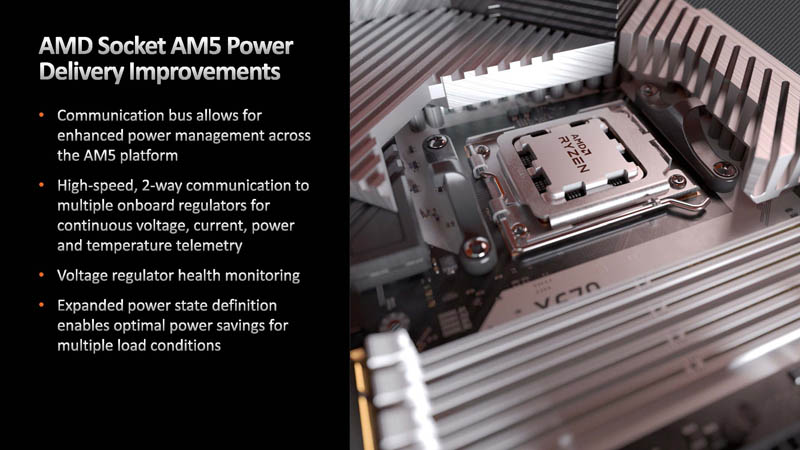
To that end, AM5 also has better power delivery. This is good to both manage power on lower-power systems, but to also provide higher-power for chips like the AMD Ryzen 9 7950X that we are reviewing.

Part of the AMD AM5 platform is DDR5 support. AMD is also adding AMD EXPO for DDR5 overclocking. AMD’s platforms typically benefit from overclocked memory controllers.
AMD has other features such as the ability to support BIOS flashback to allow a system to upgrade BIOS for a new CPU without having to have an older CPU generation installed first. At STH, we had a number of readers buy Ryzen 3000 and 5000 generation parts only to find their AM4 platforms had an older BIOS that required an older generation CPU to update. Now, AMD has a solution so users will not need another CPU to upgrade the firmware on an older system.
AMD X670E and X670 Chipsets
The AMD X670E and X670 chipsets have very similar features, but this diagram shows something really interesting. The first feature we notice is that we get a more higher-speed USB ports with 10Gbps and 20Gbps ports becoming more common in this generation. The interesting part is that the X670 and X670E are actually two-chip chipset solutions. One can see the upstream and downstream ports here. The upstream chip has usually the higher-performing I/O. The downstream chip connects through the upstream chip to the CPU and carries lower-value I/O.
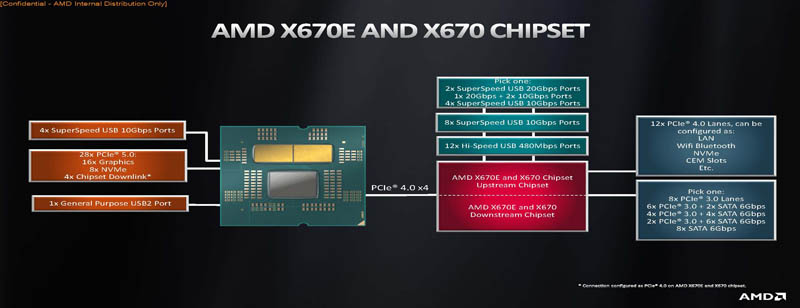
This is fascinating but it provides an enormous benefit. Here is the Falcon Northwest Talon system with the AMD Ryzen 9 7950X, and an ASUS X670E ROG CROSSHAIR Hero motherboard.
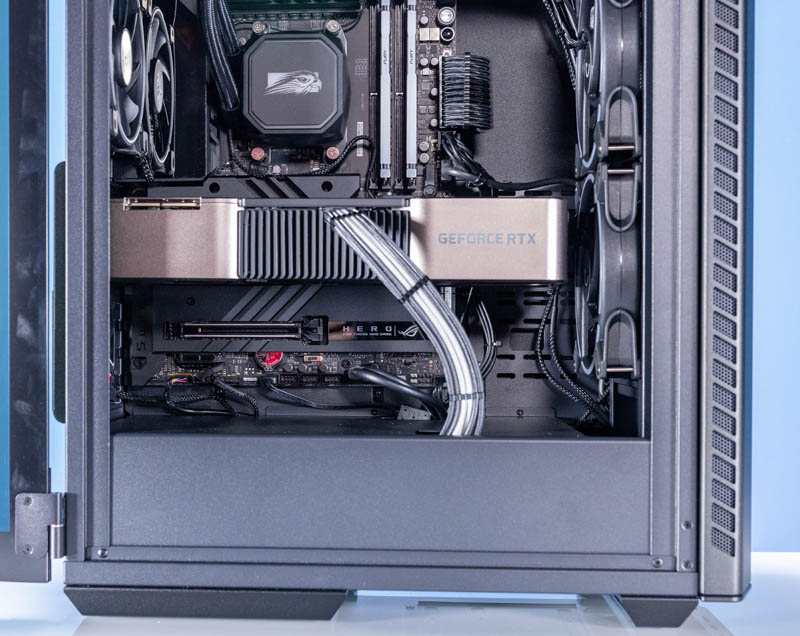
One does not see a chipset fan here. The reason is that by splitting the chipset, the TDP of each chip is lower and placement can be far enough that passive cooling can be used.
Between the CPU and the new X670E chipset, the USB loadout of the ASUS motherboard in the Falcon Northwest test system is absolutely massive. We will quickly note that the 40Gbps USB 4 support is provided by an ASMedia controller sitting on some of the PCIe lanes. This is a ~$699 MSRP motherboard, and is not even the top end, but it has extra features because of that pricing and the platform.

The X670E and X670 are differentiated mostly by the PCIe Gen5 support. PCIe Gen5 is still early in its adoption cycle and with the new NVIDIA GTC 2022 Fall Keynote showing the NVIDIA GeForce RTX 4000 series with only PCIe Gen4 support, many users will not need PCIe Gen5 in this generation. X670 is there to lower motherboard costs against that reality.
The AMD B650E and B650 chipsets are similarly differentiated from one another because of this PCIe Gen5 support and the extra costs it adds to motherboards.

The B650E and B650 only have one chipset, so I/O is more limited. It also makes them lower-cost solutions that require less physical space to implement.
Final Words
Overall, the new AMD Ryzen 7000 series SoC, the AM5 platform, and the new chipsets are important step for the company. Socket AM4 was starting to feel ancient, and it is great to see AMD replatform to something more modern.
Stay tuned to STH as we have a deeper dive into Zen 4 along with performance figures. As we mentioned earlier in this piece, we just got stuck with too few days to get this done, but those portions are in the production pipeline so they will be coming soon along with a video with everything that is in the editing queue already.


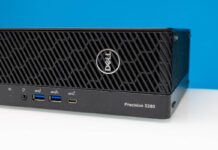

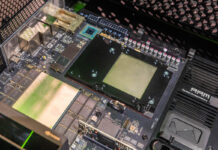
I see the limitation to 4 Lanes of the gen4 chipset uplink to the CPU very critical. In case of parallel use with high bandwidth devices like 10G+ Lan, more PCIe-SSDs or highspeed USB-Devices connected to the chipset’s lanes and ports, that will become soon a bottleneck.
The typical gamer wont notice, but prosumers wanting build homelab servers and virtualization machines.
Especially when thinking about the future years. Hopefully, future AM5 CPUs and chipsets have the ability to switch here to PCIe5 CPUchipset links.
In my eyes, that gen4x4 link to the chipset is a hefty letdown, especially vs current Intel gen12/13 with their already existing gen4x8 link.
Btw, is Ryzen 7000 able to do PCIe-Bifurcation x4x4x4x4 or x8x4x4 of it’s x16 slot like most AM4 solutions did? Or limited like Intel to x8x8 ?
So, uh, anyone know of a reasonably priced x8/x8 + x4 AM5 mobo? Can’t find one, me.
Check this out on @Newegg: MSI PRO PRO X670-P WIFI DDR5 AM5 AMD Ryzen™ 7000 Series SATA 6Gb/s ATX Motherboards, Wi-Fi 6E, 2.5G Network Solution, Frozr AI Cooling.
I feel like the only reason they really needed to move to AM5 was for the near- doubling of their power draw.
And keeping the cpu size the same for “compatibility with existing cooling solutions” isn’t great, if all the new chips except for the low end require water cooling.
Going from 142w max power draw to 240w max power draw on the socket is definitely one way to increase performance, but it doesn’t bode well for actual day-to-day use. Especially since the price of electricity is only going up.
An intriguing bit of the Anandtech article is when they down-powered it to a 65w power envelope, and only lost a few percentage off of the performance numbers. It really seems to indicate that the idea was win at any (power/heat) cost, even when they had designed an efficient new CPU.
I hope you also test AVX512 part of CPU
@AM5finderAM4lover – that board is x16/x4 from the CPU, plus an x2 and an x1 from the chipset.
So x16/x4+x2. Not x8/x8+x4.
Thanks anyway.
With the addional 4 Lanes AM5 got, i’d hope the x16 Slot could be bifurcated to x8x4x4 or x4x4x4x4 (via riser cards) plus having the two x4 lanegroups from the SSD channels.
Leaving the x4-Link to the chipset untouched of course.
Meaning, that would give up to six x4 I/O Slots directly attached to the CPU . E.g. for ZFS M.2 storage devices or converted via riser cable to real Slots e.g. for Hostbusadapters to avoid running this traffic via the narrow cpu>chipset link.
With lots of AM4 boards, this is possible to with the x16+x4 from the CPU (obviously then just five x4 connections).
This flexible bifurcation of the x16 Slot is pretty handy and gives great flexibility to AM4 reducing the pain of limited lane count pretty much. Intel does not offer that, they allow only x8x8.
If AM5 took this away > would be bad for homeserver and ZFS community. AM4 has a huge advantage there over its competitor.
Any word about ECC support? Ok, there are the Gigabyte server boards that support ECC (do they), but is this generally left to the board manufacturer as in AM4?
Btw, meanwhile i have the information for 2-3 Boards: they can set their x16 Slot to x8x8 (obviously possible as there are boards with two x8 slots), x8x4x4 and x4x4x4x4 bifurcation mode. Works like AM4, no backpedaling.
I asked a german PC enthusianst whilch he was videostreaming to check the Bios setting for Bifurcation, Board was Asrock X670E Pro RS.
Some board manuals say ECC and differentiate also between ECC and on-die-ECC, but there are hardly any DDR5 with real ECC available yet.
So, pretty good news for enthusiasts.
@syskeytechnician thx for the info about bifurcation